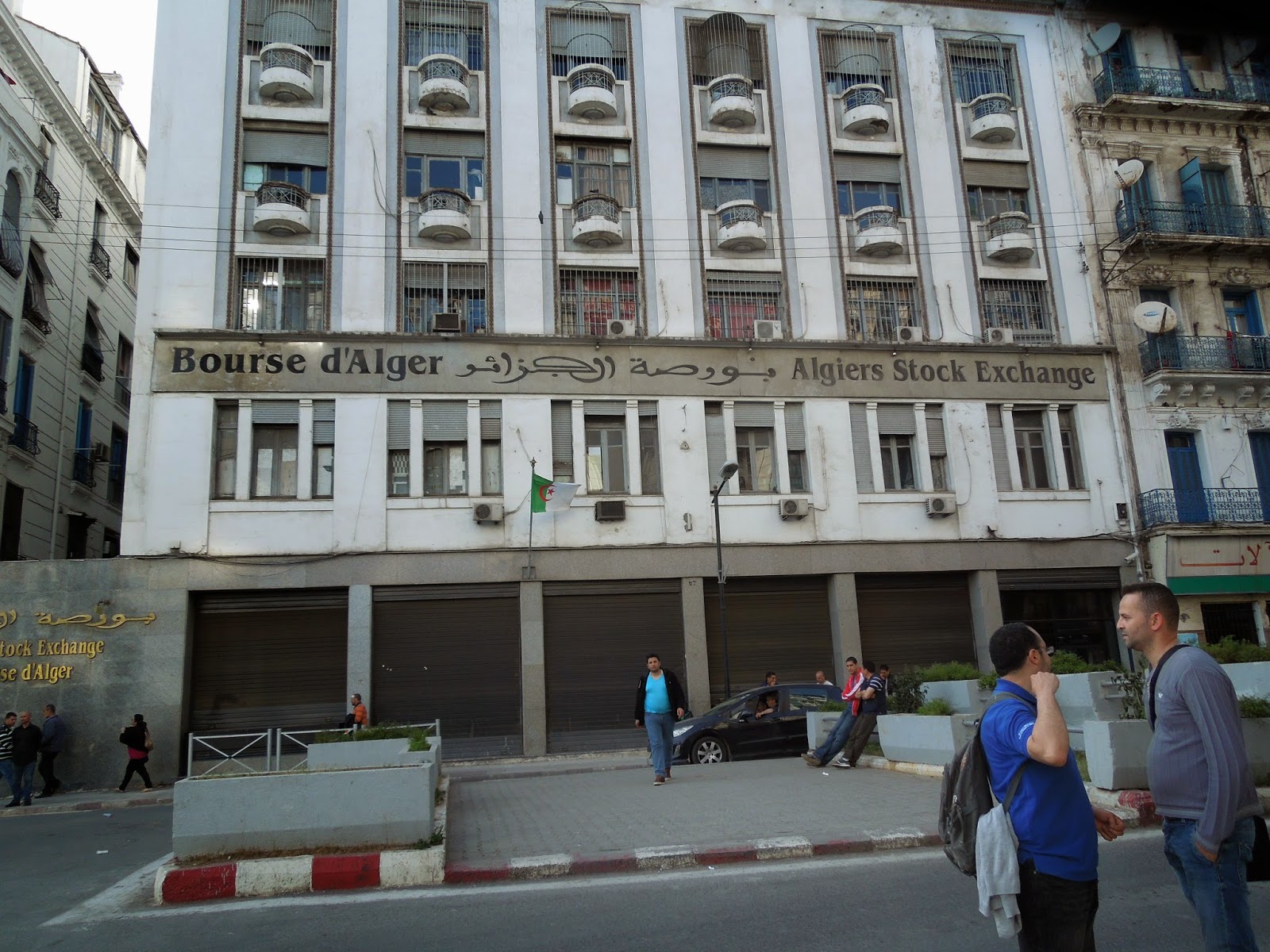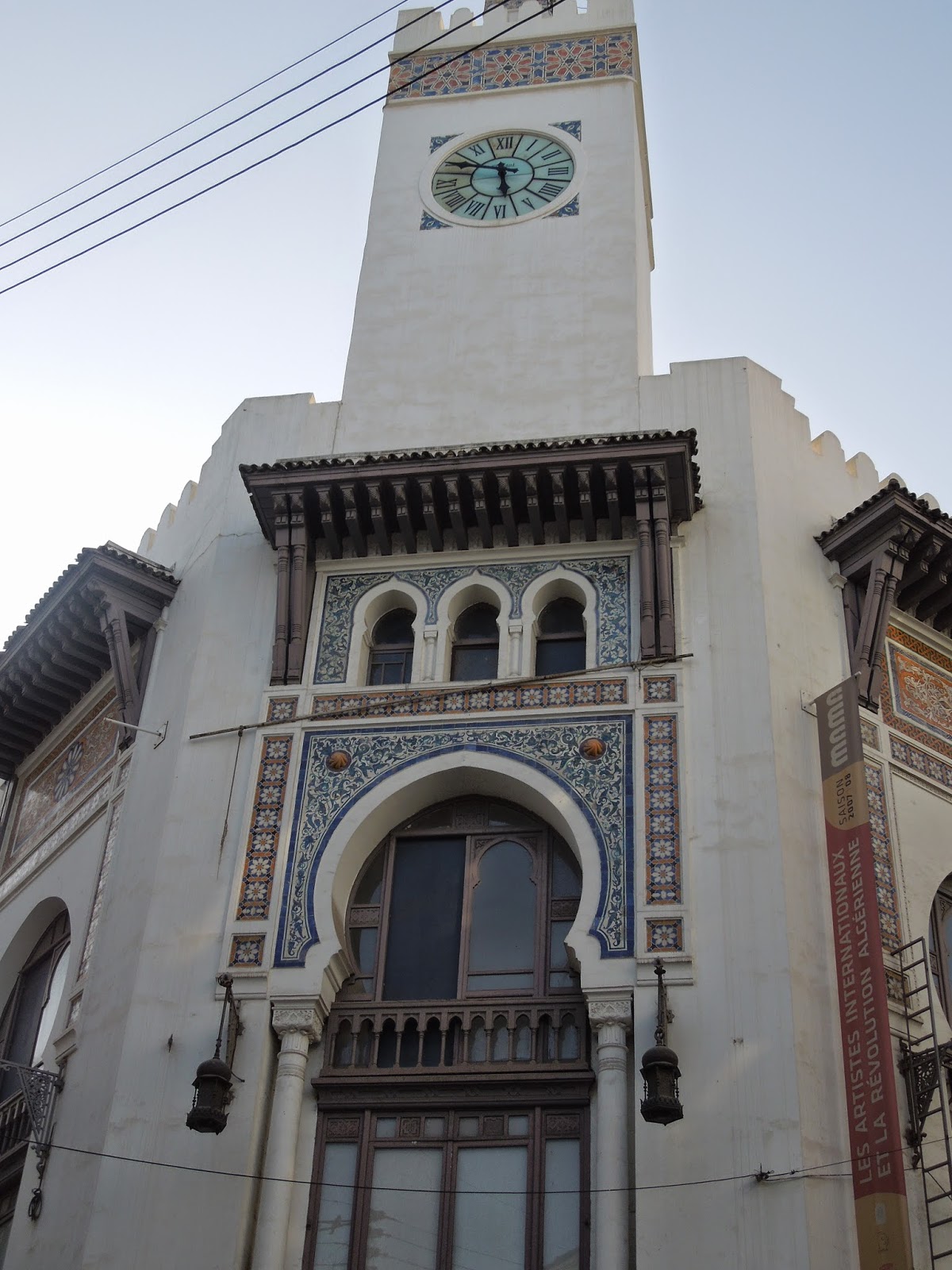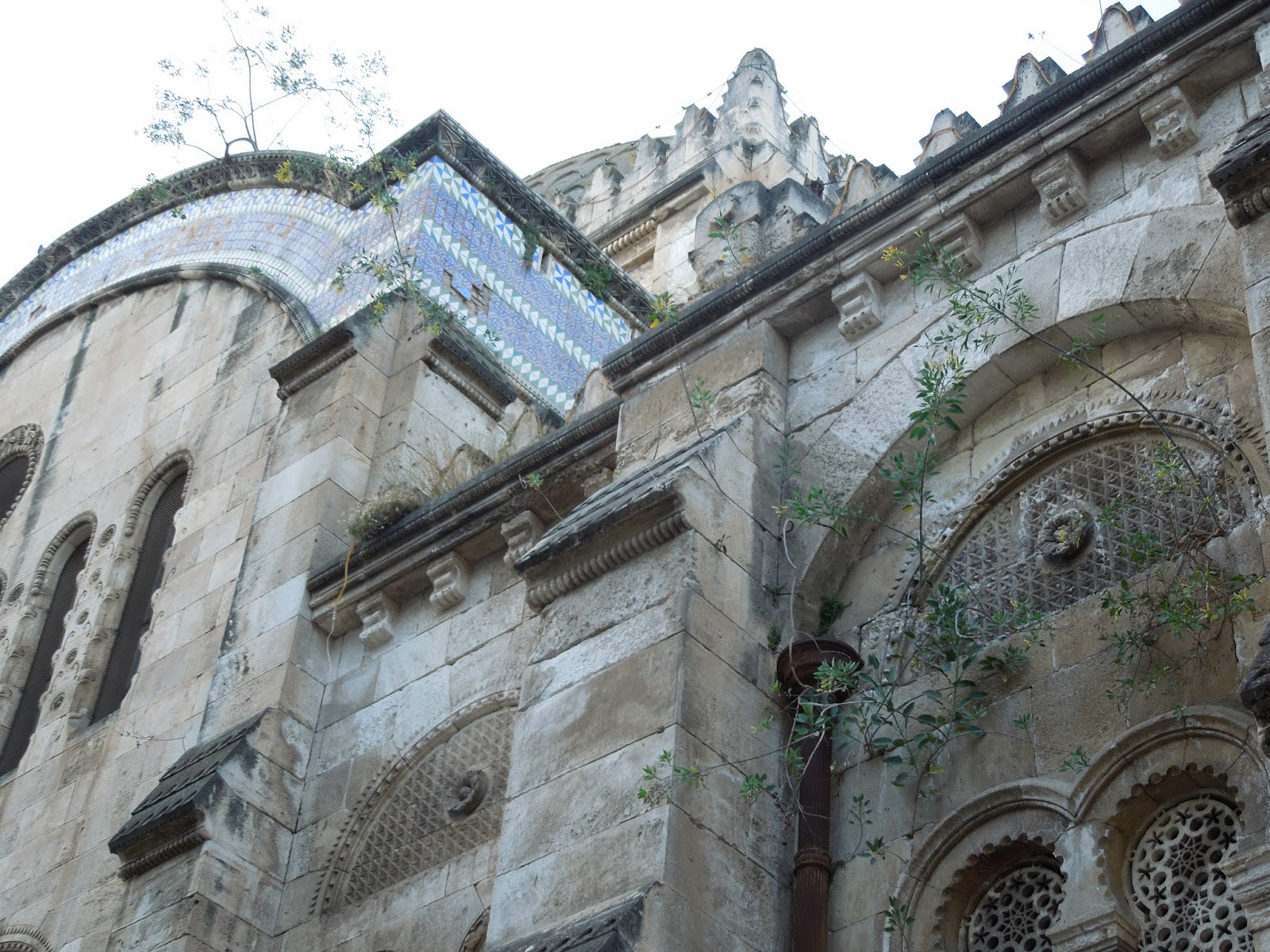Our last adventure in Algeria began on Monday when we (Randy, Alice, Rafik and Rafik's fellow doctoral student and friend, Djamel Eddine Chafai and another friend and doctoral student, Ehcen) headed out in the morning for a road trip to Algiers, the capital and largest city of Algeria. It lies some 150 miles or so west of Bejaia, also on the coast. Because the road from Bejaia to where it picks up the highway is bad, the journey takes some four or more hours. Traffic was also heavy until we reached the highway. But the weather was great and we stopped for lunch mid-way so it was a fine trip. We saw many cranes nesting on electric poles along the way, especially when we detoured on a country road to avoid the traffic near an industrial area (food production including dairy is important in this part of Algeria).
 |
| The guys in the back of Rafik's truck on the road to Algiers (isn't that the title of a movie?) |
 |
| One of the big and beautiful storks in its nest along the back road |
 |
| A stork flying |
 |
| This road seemed to be stork heaven |
 |
| The restaurant en route didn't look like much but it was tasty and clean |
 |
| Djamel and Randy wait for lunch |
 |
| Ehcen, Alice and Rafik are hungry too |
 |
| Lunch salad with French bread and hummus (Algerian version - roasted peppers and tomatoes with olive oil) in the background |
 |
| The meat grillers outside of the restaurant. Kabylie people like their meat (beef, chicken and lamb) |
 |
| The raw ingredients on display in the front of the restaurant. This is common in Algeria so you can pick before you eat if you like. |
Upon arrival in Algiers we found a hotel near the airport. It was really an awful hotel - overpriced, dilapidated, and lacking in every way. In its favor parking was easy and it was relatively clean. We decided for one night it could be bearable - sort of like camping out but in a hotel room. We then headed to the city center. Again, because of traffic it took some time to get there and find a place to park in a large parking garage near the sea. We walked through the old French part of the city and met up with Djamal's friend Abdoullah who is a professor of Italian (!) at Algiers University. He knows the city well and showed us the casbah and souk areas briefly (dirty and crowded - they sound romantic but are totally not).
 |
| The dreadful airport hotel in Algiers - no AC, no WIFI in the rooms, an elevator that didn't work, sagging curtains, etc. |
 |
| The furniture of the hotel |
 |
| View from our room - a parking lot |
 |
| On the main shopping street in Algiers |
 |
| The Algiers Stock Exchange |
 |
| The sign is more impressive than the building |
 |
| The beautiful French architecture was everywhere in the city |
 |
| We admired the Post Building |
 |
| The justly famed Post Building in the city center |
 |
| A selfie with this pretty building and the nice weather |
 |
| Djamel took our photo in front of it |
 |
| A nearby building exhibits Arabian architecture |
 |
| Our friend Bouteflika was everywhere |
 |
| A wedding party included a truck load of musicians playing loudly |
 |
| The statue in the center city of a hero knight |
 |
| Another beautiful and unique building |
 |
| The Italian style main theater |
 |
| The director (on left) gave us a brief tour of the theater. On right is our Professor of Italian friend and guide Abdoullah. |
 |
| The casbah old area |
 |
| We did not venture down the really narrow streets |
 |
| Another casbah street |
 |
| The souk is the shopping area of the casbah |
 |
| An aged mosque with trees growing out of it |
 |
| The Algerian flag flies proudly in the casbah. Algeria made it to the World Cup in Brazil this year so we will be cheering for the team. |
We walked along the promenade on the sea front where the government buildings are. These are attractive and well kept. The city hall is especially noteworthy as it uses traditional North African architecture. Photographs are not allowed of the government buildings (Algeria is a paranoid police state) so none are posted on this blog.
 |
| One of the historic mosques in the city. Some of the mosques are converted churches. In Algeria, the people pronounce mosque as mos - kay. |
 |
| Panorama of the seafront from the promenade |
 |
| Panorama of the buildings, many governmental, from the promenade |
 |
| The seaport of Algiers |
 |
| Some of the seafront buildings - the guys discuss where to go next |
 |
| The central train station of Algiers |
 |
| A pretty mosque between two government buildings (we had to get permission from the guard of one of the buildings to take this photo) |
Needing to celebrate our last night in Algeria a restaurant called La Baie d'Alger in this area of public buildings was found which serves alcohol. We had a nice dinner with some good Algerian wine. The restaurant filled up as we ate and was mainly men but also a few couples including some foreign (European or North American) people.
 |
| Our dinner location in Algiers |
 |
| The front of the restaurant doesn't look like much but it was centrally located, friendly and tasty |
 |
| The guys order their meal |
 |
| We had two bottles of red wine from Tlemcen, a historic and supposedly very pretty city in Algeria. The wine was actually very good. |
 |
| The tomato salad |
 |
| Alice's fish look a little scary but were delicious. Notice the twin starches - potatoes and rice and the ubiquitous (and delicious) carrots. |
 |
| Our guide for the evening in Algiers Abdoullah and Randy enjoy dinner |
We said good bye to our Italian professor friend and drove to the hotel for the night. In Algiers there are police road blocks everywhere. They shut down all lanes but one and you pass slowly as they look over the car and occupants. At night, the standard drill is to turn on the car's inside light as you approach one of these so that the police can see easily inside. To us, this felt like being in a spy novel but to Algerians, it part of their regular lives. They are used to strong police presence and intrusive behavior on the part of the government. In Bejaia this was much less evident but in Algiers, the military and police are in full force.
After the same breakfast of croissants, coffee, yogurt and jam (not a bad combination), we headed back to the city for more sightseeing. Djamel had departed to visit his mother at another city so we were down to four. Our goal was first the Antiquities Museum where we met one of Rafik's friends, Ghelas, who lives in Algiers and works there. This museum was very rewarding with treasures from the Roman age (and before and after). The mosaics were particularly impressive. The museum had a weird rule about photographs. You were allowed one each (so we got a total of four or five) but the photo had to be you with the artwork (the photo was deemed a souvenir of the experience). The guard also gave us an extra bonus photograph of all of us by a carving depicting something important in the Christian heritage (so the guard indicated) but we were never sure what.
 |
| Park near the antiquities museum |
 |
| View of the park |
 |
| Rafik (right) and his friend Ghelas outside of the antiquities museum |
 |
| The entrance to the very good antiquities museum |
 |
| One of the buildings (this one) houses the Islamic Arts which we did not have time to see |
 |
| One of the wonderful Roman mosaics in the museum |
 |
| One of our "souvenir" photos - a tremendous mosaic |
 |
| Our special souvenir photo with the sarcophagus carvings that are "special to Christians" |
We had intended to go also to the nearby Bardo Museum but time was slipping by so that will have to wait until the next visit. Instead we opted for the fine church on a hillside outside the city center but still in the city. This church is Basilica of the Notre Dame of Africa and was built in the late 1800's by the French. The setting is wonderful with full views of the sea and the city of Algiers. The church is an operating church (mass is said each evening) and was a nice combination of traditional with some African and Arabic touches.
 |
| Entrance to the church |
 |
| The church exterior with its unique architecture - a combination of exotic (Northern Africa) and traditional (French) |
 |
| Randy admires the view of the Med |
 |
| Photos were not allowed but Alice shot some anyway. The "black" Virgin is the venerable statue for which the church was constructed. Note the wall decoration which is like none you find in Europe. |
 |
| Some windows with a message in Kabylie |
 |
| The amazing organ with its Arabian motif |
 |
| The interesting paintings in the apse |
 |
| Another view from outside |
 |
| A selfie at this highlight of Algiers |
 |
| Detail of the steeple |
 |
| The beautiful tilework |
 |
| Sightseers at the overlook at the church - it is set high on a hill on the western part of Algiers |
 |
| Our Lady of Africa |
We then fought more traffic through the city and decided to have lunch near the airport area to save time. This was interesting because we ate a restaurant in a mall. This was the first (and only) mall we saw in Algeria. It was a typical modern shopping experience with several floors, escalators, a large supermarket and upscale shops and restaurants. It was an interesting contrast to the jumble and disorder of the city center and what we experienced in Bejaia. But, shopping malls are essentially the same worldwide so the authenticity of those chaotic cities is much more interesting and educational.
 |
| The modern shopping mall near the airport in Algiers - but, of course we had to park in the dirt |
 |
| The restaurant in the mall with the weird name - Algerian take on upscale American perhaps |
 |
| Rafik and Ghelas enjoyed their lunch |
After getting our luggage from the hotel we headed to the airport where check in was surprisingly efficient. We shared a last drink with Rafik and his friend and had to say goodbye. As we boarded our Turkish Air flight to Izmir, changing in Istanbul, we were relieved to enter the known world again and its comforts.
 |
| Rafik and Randy share a last tea at the airport after checking in |
Our experience in Algeria was one we were so glad to have. The people were uniformly welcoming and friendly. We never felt threatened in anyway. The biggest hardships we had to put up with were uncomfortable beds and pillows and some less than appealing bathrooms. Potholes and roads that can hardly be called that are part of daily living in Algeria. We felt that Algeria has so much potential - it is big with natural beauty and natural resources. It has an interesting history and an interesting ethnic mix. Among the Berber peoples we saw blonds, red heads and many blue and green eyes. In my research, slightly more than 20% of the Kabylie gene pool is Nordic, probably a remnant of the Viking kingdoms established long ago in North Africa. The government is clearly repressive and corrupt, and that is the main problem. The wealth generated by oil and gas is not reinvested in the infrastructure of the country nor in its ordinary peoples, especially the Berbers. This is an unfortunate, but not unusual, situation in the world today.
All in all, we would return to Algeria. There is much more to see in Algiers and in other parts of the country. We also want to return to the welcoming arms of our Kabylie family in Bejaia. But next time, hotels (at least in Algiers) will be chosen with more care so we can retreat in the evenings to a standard of comfort we are more accustomed to. We also need to brush up on our French so we can deal better with restaurants and shop keepers. These are small things though - as experiences go, our adventure in Algeria was a positive and unique one!
 |
| Rafik and Alice in a dual selfie. Thanks to the Medjoudj family and especially our Kabylie "son" Rafik for making this wonderful experience possible! |










































































Thanks Professor Alice for this pleasants days and i like the pictures.
ReplyDeleteAhcene Boulayoune (Ehcen as you call me)!